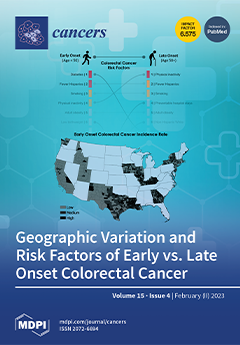Targeting PI3Kδ has emerged as a promising therapy for hematologic and non-hematologic malignancies. Previously, we identified an oncogenic splice variant,
PIK3CD-S, conferring Idelalisib resistance in African American (AA) prostate cancer (PCa). In the current study, we employed a comprehensive analysis combining molecular
[...] Read more.
Targeting PI3Kδ has emerged as a promising therapy for hematologic and non-hematologic malignancies. Previously, we identified an oncogenic splice variant,
PIK3CD-S, conferring Idelalisib resistance in African American (AA) prostate cancer (PCa). In the current study, we employed a comprehensive analysis combining molecular biology, biochemistry, histology, in silico simulation, and in vitro functional assays to investigate the
PIK3CD-S expression profiles in PCa samples and to elucidate the drug resistance mechanism mediated by PI3Kδ-S (encoded by
PIK3CD-S). The immunohistochemistry, RT-PCR, and Western blot assays first confirmed that PI3Kδ-S is highly expressed in AA PCa. Compared with PCa expressing the full-length PI3Kδ-L, PCa expressing PI3Kδ-S exhibits enhanced drug resistance properties, including a higher cell viability, more antiapoptotic and invasive capacities, and constitutively activated PI3K/AKT signaling, in the presence of PI3Kδ/PI3K inhibitors (Idelalisib, Seletalisib, Wortmannin, and Dactolisib). Molecular docking, ATP-competitive assays, and PI3 kinase assays have further indicated a drastically reduced affinity of PI3Kδ inhibitors with PI3Kδ-S vs. PI3Kδ-L, attributed to the lack of core binding residues in the PI3Kδ-S catalytic domain. Additionally, SRSF2 has been identified as a critical splicing factor mediating exon 20 skipping in
PIK3CD pre-mRNA. The inhibition of the SRSF2 activity by SRPIN340 successfully sensitizes AA PCa cells to PI3Kδ inhibitors, suggesting a novel therapeutic option for Idelalisib-resistant tumors.
Full article






